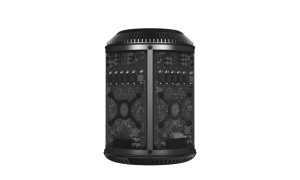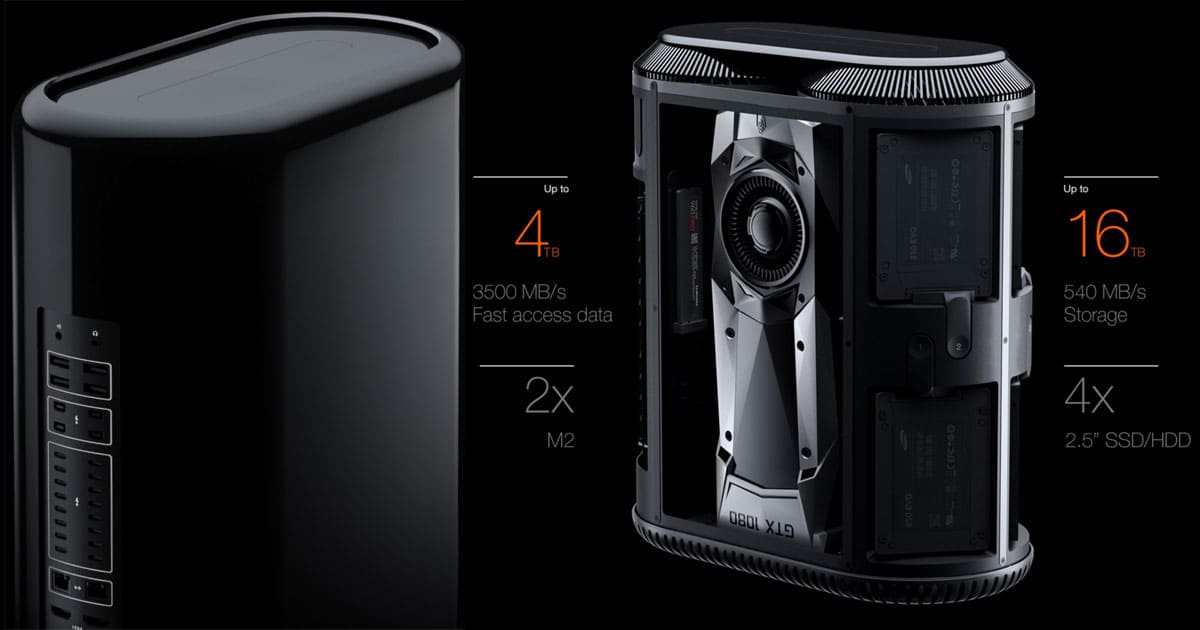The Particle Debris article of the week is by Matthew Panzarino at Tech Crunch. It’s about Apple’s 2019 Mac Pro.
This excellent article has been excerpted and analyzed by many, but my advice is to just read author Panzarino’s article for its full scope and insights.
Technical Admiration

I’d like to add something, however, that hasn’t been widely discussed. And that is the notion of technical admiration and aspiration versus mere aesthetic design.
The best way to explain that is with an example. The latest MacBook Pros use a CPU that’s technically capable of addressing 32 GB of RAM. However the maximum Apple offers is 16 GB. That’s, as I understand it, to manage the thermal load for that (thin) case design. Other companies, like, HP offer powerful ZBook notebooks that have a 32 GB option. They are thicker. While the MacBook Pro is a beautiful, capable computer, it can fail to excite those who have great technical demands, and it’s accordingly hard to get wound up.
That’s just an illustrative example of one performance spec.
This matter is a delicate proposition for Apple. Cool running MacBook Pros that have a long battery life appeal to a wide range of mobile creative and technical professionals. But when there’s a demand for the highest possible performance, there are ways to design a computer whose sex appeal is in the performance specs, not in the thin curve of the aluminum case.
iMac Pro Paves the Way for Mac Pro
The 2013 Mac Pro, while technically impressive in some ways, paid too much attention to the physical design. As a result, over the last few years, Apple has come to the realization that a “Pro” computer isn’t like those of old—a mere bump in specs over the consumer model. Instead, as author Panzarino explains, Apple is now thinking about the technical allure of a computer that can really whet the appetite of the professional.
That means a no-nonsense, no limits approach and a Mac that’s going to cost significantly more but pay off for the customer in terms ROI. If the iMac Pro is any example, we’re seeing a shift towards Macs that, while they still look good, have appeal primarily in what they can do for the corporate, research, and government customer. It’s like the halcyon days of the Sun and SGI workstations that were purchased by organizations, not individuals.
Form Follows Function
That doesn’t mean that I expect the 2019 Mac Pro to be an ugly tower. It will, of course, look cool. But the physical design will be dictated by the modularity, thermal design, and connectivity. We’ll salivate over the specs, not the looks. Mostly.
Accordingly it will be expensive. More than any of us mere mortals can afford individually. That’s because, I predict, this Mac Pro will have some extra special hardware, hardware that’s designed to eradicate computational and UI roadblocks. It’s going to take some time to develop a new level of hardware integration and marry that with a macOS that fully exploits the hardware.
Mac mini Salvation
Because this new Mac Pro won’t ship until 2019, I doubt it will be mentioned at WWDC in June. Instead, for those individuals who need a reasonably powerful headless Mac, I’d like to see Apple ship a newly designed Mac mini. I’m thinking along the lines of the HP Z2 mini that I reviewed.
[HP Caters to Creative/Tech Pros with Z2 Mini PC]
Something small and good looking is called for. For example, a Xeon Quad-core processor, great—but not exotic—graphics, up to 32 GB of RAM, 1 TB SSD, $1800.
The new Canon Lake MacBook Pros, upgraded iMacs, the iMac Pro, and a fast, sexy Mac mini would hold the fort nicely while we wait for that computational monster, the 2019 Mac Pro. The technical allure of this kind of Mac family would once again have us wildly enthusiastic about the Mac’s future.
Next Page: The News Debris for the week of April 2nd. Money can’t always buy engineering R&D success.

John:
Some great reads here. Since I’m actually supposed to be working, I’ll confine my comments to the following.
First, Matthew Panzarino’s article on the 2019 Mac Pro provides useful insights into the Mac Pro’s development that provides a window into the likely thinking that will guide not only the Mac Pro’s, but other product line’s, specifically function over form served by workflow and modularity. Interestingly, in my line of work, given the ever expanding complexity of systems, be they clinical, laboratory or analytical, they are increasingly being governed by modularity in design, specifically in order to address an ever widening array of end user need. For most complex systems, the days of a one size fits all product are over. Even if if a given design can address the majority of use cases, there will be others, particularly in diversified use cases, that are not optimally or even adequately addressed. As complex systems, why should hardware be any different? This also underscores the need for workforce diversity, as only a representative workforce can ultimately produce a broadly representative and utilitarian product. As for the Mac Pro, I hope that this thinking will inform the development of the next gen MacBook Pro. I had to spring for an update to my venerable 2011 MBP when my son’s MBP died, with the 2017 TouchBar Kaby Lake powered MBP, which I had originally decided to bypass due to the anaemic 16 GB of RAM. While I appreciate the Touch Bar more than I anticipated, this is a device where form over-rode function (heat management in the thin housing).
Will Knight’s piece on AI should be a sobering read, not simply for Americans, but anyone who appreciates the analytical and developmental power that funded, directed research brings to development, including critical primary or basic research. When countries, including one as wealthy and powerful as the USA, opts against this investment, it not only fails to keep pace with well-resourced competitors, it bleeds talent whilst simultaneously discouraging the recruitment of fresh blood. This is precisely what happened with particle physics and decision not to build a super-collider in the USA. The centre of mass is now in CERN, including the talent. AI is the future workhorse of multiple industries, apart from the tech sector per se, be they transportation, logistics, medicine, and importantly the military. One should think that the top brass of any country know this, and would vociferously advocate for such investment. Well, the USA may not lead in AI, and be bettered by their enemies, but if it’s any consolation, they’ll have coal.
Malcolm Owen’s piece on MicroLED is both exciting as well as yet another example of Apple thinking several steps ahead and playing the long game. Can’t wait to see this in an upcoming Apple Watch, and what that will do for both form and function. Oh yes, and the iPhone and iPad.
Duty calls.
Very interesting articles, thank you.
Apple sure is trying to bring a lot of production in house.
Thank you.
The RAM limitation for MacBooks Pro is the CPUs don’t support 32GB of high speed RAM, only 16GB. Same thing for the much anticipated six core i9 slated for this year, so faster CPU, still only 16GB RAM, which really takes the sizzle out of new MacBooks Pro.
I have better hopes for iMac, and in my dreams Mac Mini, which should be a really desirable Mac – with the only compromise being display, keyboard, etc… but sadly, hasn’t yet.
About the ARM processors, see today’s Joy of Tech comic
http://www.geekculture.com/joyoftech/joyarchives/2505.html